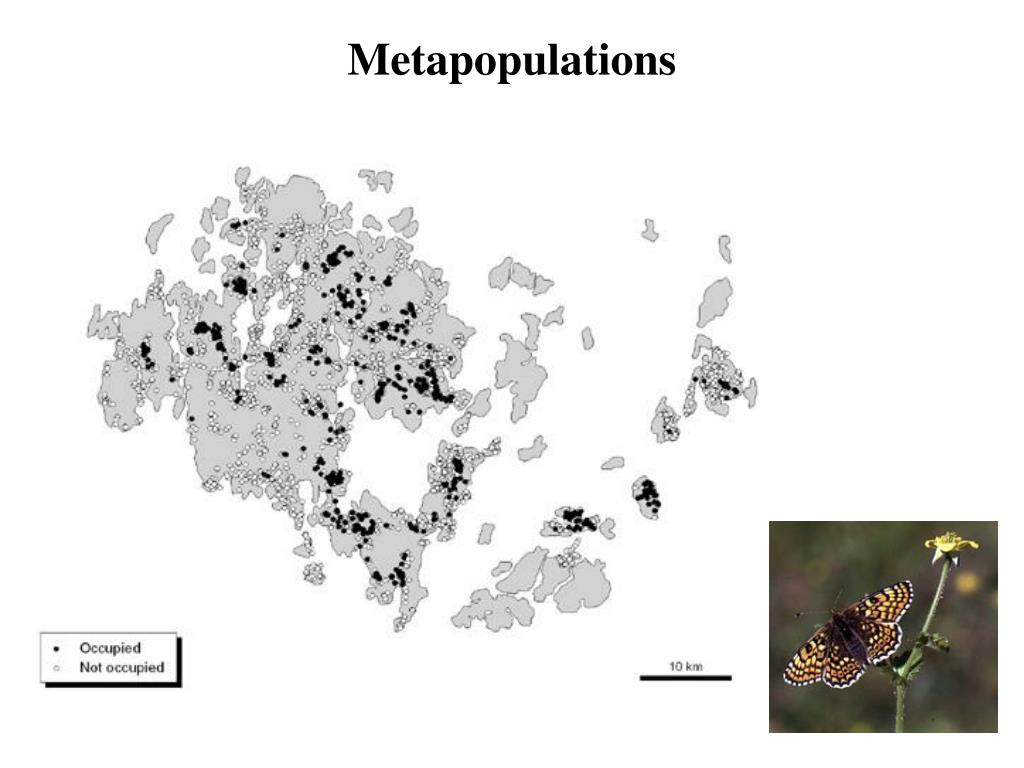Most of population ecology focuses on births and deaths, disregarding the immmigration or emigration of individuals into or out of the population. Spatial ecology takes up the topic of movement and explores how the quality of living conditions for a species varies within its territory. The list of conditions within which a species flourishes is called its ecological niche. Spatial ecology looks at the tradeoffs between finding one’s niche and escaping the crowded conditions that sometimes arise there.
Spreading out
The rate of spread for a species is particularly interesting for those that are invading a new habitat. Under most conditions, the increase in distance from the centre of the outbreak is equal to 2 (Dr)1/2 . Where D is related to the average dispersal distance and r is the rate of population growth. So, a population that either grows quickly or disperses larger distances spreads out more quickly. Much depends on how frequently the plant or animal ventures far from its place of birth. When the species is designed for dispersal, the rate of spread can accelerate over generations.
For plants, three types of dispersal and survival patterns are recognized:
- Jansen-Connell – where seedlings are found at a moderate distance from the parent despite the fact that most seeds land near the parent
- Hubbell – where seedlings are found close to the parent even though their chance of survival is worse there
- McCanny – where seedlings are found close to their parent because their chance of survival is better there.
In this latter pattern, named after me, niche characteristics are more important than competing with one’s siblings for survival.
Going meta

Populations can often be divided into local populations that occasionally disappear and, perhaps later, reappear. This group of local poulations is called a metapopulation. Local populations occur in patches of especially good growing conditions (e.g. a forest clearing). Even though the local populations are unstable, the metapopulation is likely to persist as long as the chance of establishing in a new patch is greater than the chance that the population in an established patch will “wink out”. This usually comes down to having good dispersal mechanisms.
One place where metapopulations are studied is on groups of islands. The Theory of Island Biogeography was proposed to predict the consequences of dispersal and local extinction for communities of species. MacArthur and Wilson attempted to predict the number of species on an island based on its area and its distance from the mainland. Both of these factors affect the likelihood of dispersal to an island from the mainland. Island size allows for a larger population size and presumably a lower chance of local extinction. It was an elegant theory but it did not work all that well. A recent review of the field shows that the distance from the mainland plays a small role in predicting the number of species on an island. Surface area is effective in narrowing down the number of species that an island can maintain but the relationship between the two variables is inconsistent and heavily influenced by the size of the total species pool and the size and arrangement of islands in the archipelago.
Stephen Hubbell, referred to above for his work on seed dispersal, expanded the theory of island biogeography to include all kinds of habitat patches as well as the process of forming new species. This Unified Neutral Theory of Biodiversity and Biogeography assumes that there are no great differences between the physical conditions and prey needed by the species in an ecological community. Where niche differences do not matter, communities would form as a result of ecological drift, a random process of dispersal, survival and speciation. Here, too, the theory does not match well with ecological observation. An analysis of 158 metacommunity datasets showed that 44% of the studies were best explained by differences in the ecological niches of the species, while 8% of the studies were consistent with ecological drift. A group of 29% of the studies showed a combination of niche and dispersal effects. Though dispersal does not seem to be the most important factor in determining the species in an ecological community, neutral theories are a good starting place when it is daunting to measure all the physical conditions and prey types that species might prefer.
A grand theory?
I find it fascinating that both natural selection and the rules for assembling ecological communities are governed by the suitability of an organism to its environment and the isolation of small groups of organisms. These threads have not led us to predictive theories in either domain but the suggestion of a grand theory uniting evolution and ecology is quite exciting.
